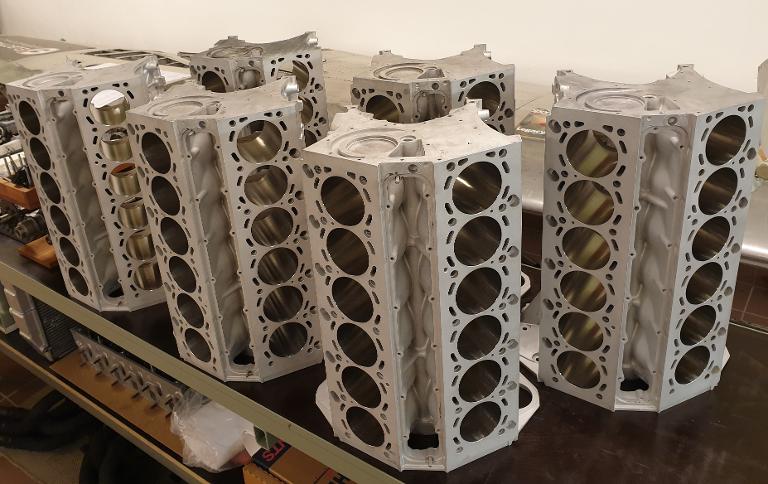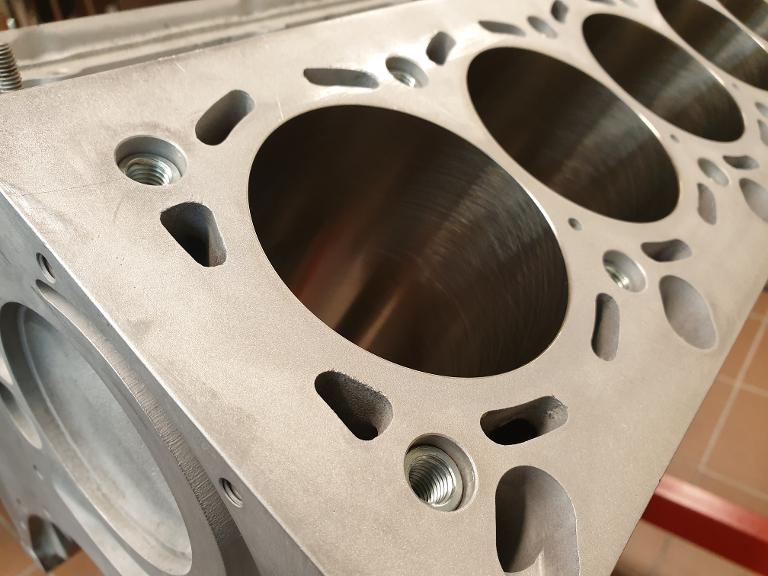AluSil
AluSil is a hypereutectic aluminium-silicone alloy which contains approximateley 78% aluminium an 17 % silicone. The AluSil aluminium alloy is commonly used to make linerless aluminium alloy engine blocks. AluSil, when etched, will expose a very hard silicone precipitate. The silicone surface is non-porus enough to hold oil, and is an excellent bearing surface. BMW switched from NikaSil coated cylinder walls to AluSil in 1996, to eliminate the corrosion problems caused through the use of gasoline containing sulfur. The production cost of the engine block was also reduced substantially by using the AluSil technology. The M73-B54 V12 engine is no exception, AluSil is also used as the base compound in this block!
NickaSil plating
NickaSil, is short for Nickel Silicone Carbide. Silicone carbide is a very hard ceramic substance that can be dissolved in nickel. The nickel solution can then be electroplated onto the aluminum cylinder bore. The piston rings will then "rub" off the exposed nickel, leaving a very hard layer of silicon carbide to prevent the cast iron and steel piston rings directly contacting the aluminium cylinder.With this setup, the engine tolerances can be held tighter for increased performance. NicaSil is extremely durable and does not need to be reworked as often as an iron or chrom cylinder.
The good advice
Late into the development phase of the prototype engine, Thomas Hauklien, the CEO of Edge Performance AS, www.edgeperformance.no advised us to look into cylinder coatings. Since Mr. Hauklien is a higly experienced Rotax engine builder, he has seen literally thousands of NickaSil coated cylinders. Many of these cylinders looked new, even after reaching up on TBO! Based on this knowledge, Mr. Hauklien was highly recommending this form of coating process for our engine blocks as well. We therefore contacted Millenium Technologies, www.millennium-tech.net located in Plymouth Wisconsin, USA, and made an agreement to coat all of our V12 engine blocks, six in total. We are happy to announce that the result looks very promising!
There is a lot to learn about this technology. Why would one use a plating process like this? What type of engine needs this kind of treatment, and, what are the benefits? Lets take a closer look at this very interesting product, and how the procedure/coating is applied.
Coating description
NickaSil, is an electro-composite coating consisting of a nickel metal matrix primary phase and/or hard particulate secondary phase disperced uniformely within it. The process involves electroplating nickel in the presence of hard particulates, such as SiC, under conditions allowing the hard particulate to co-deposit with the nickel. The result is an electroplated composite material where engineering thickness can be achieved for both original manufacturing (OEM) or overhaul and repair.
Electro-composite materials, such as NickaSil, are viable alternatives to Hard Chromium Plating due to their excellent wear resistance. Superior sliding wear characteristics are achieved due to the hard particulates dispersed within the metal matrix. Mating components ride on the hard particles, which can vary from SiC to BN to diamond depending on the wear condition application, resulting in wear five to ten times better than Cromium.
Once the NickaSil coating has been applied, it can be diamond honed to finish dimentions and surface finish requirments. Common applications of NickaSil are found in bores of internal combustion engines with uses ranging from weed trimmers to snowmobiles and now, into high performance aero engines! Most any cylinder bore/piston application where sliding wear resistance is important is a candidate for NicaSil electro-composites.

We have a total of six blocks that are NicaSil treated and ready for assembly when needed. Optimistic one might think.


What are the features & benefits
- Excellent sliding wear resistance, usually two to ten times better than chrome
- Buildup possible up to 0,030 Inch or 0,075 mm
- Superior adheision to all metals including aluminum and titanium
- Outstanding corrotion resistance
Properties
- Frictional properties are very good and the coating has excellent oil retention due to the oleophyllic nature of nickel and silicone carbide. The coefficient of friction can be further enhanced by adding laminar lubricants to the deposit.
- Hardness: 500 - 625 HVN100
- Corrosion resistance is outstanding and is superior to electroless nickel an chromium. In the presence of chlorides (ph+6,0), brine, and sour gasses it is superior to chromium and the other coatings.

.png?v=1611050572224)
.png?v=1611050431932)
.png?v=1611050548824)
.png?v=1611050119333)
.png?v=1611050465355)
.png?v=1611050452767)
.png?v=1611050558000)
.png?v=1611738745088)
.png?v=1611050528853)